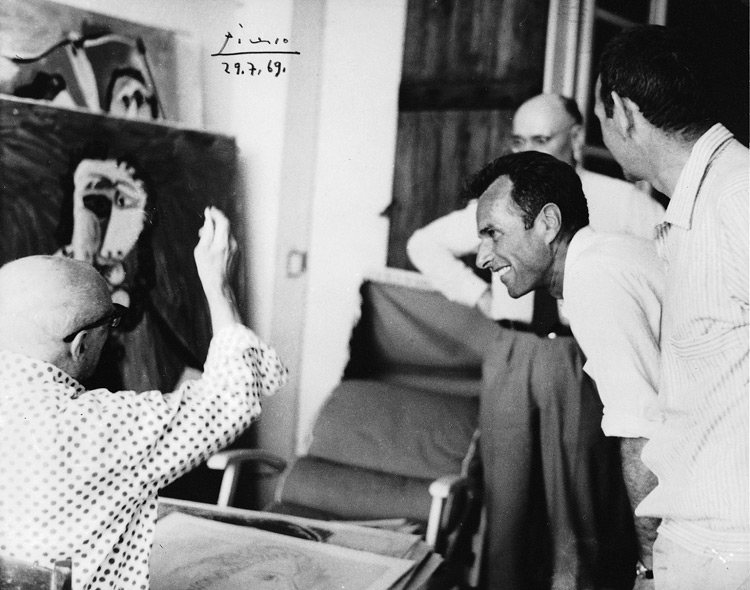The Fondation Beyeler: a Swiss jewellery nestling in a green setting
Put Basel on the map!
As a young art dealer Beyeler first wondered if he wanted to leave his native country. And the response came to him naturally. He loved his surroundings, he loved his city -Basel- and he loved his rowing club! So why move? Indeed, the young arts dealer, against all odds -Basel is a rather small city compared to Zürich , which is developing as far as art is concerned in the 1950's- decided to stay in his hometown. The young man is ambitious: rather than moving to London or Paris he wants to make the world move to Basel. He sees the town as the crossroads of Europe and wants to develop its prestige -which he did-.
 |
| A view of Ernst Beyeler's hometown: Basel |
| Fondation Beyeler, designed by Renzo Piano, 1997, Riehen |
In 1989 Beyeler's entire private collection is presented for the first time at the Centro de Arte Reina Soffia in Madrid. Beyeler starts to think seriously about the future of his collection and his and his wife Hildy's legacy - the couple has no children-. Once again the question of the setting is raised. First, the possibility of bequesting the collection to the Kunstmuseum Basel was considered, or even to Paris' Centre Pompidou or the MoMA in New York. However, Ernst and Hildy Beyeler could not accept to see their collection only twice a year, as moving to a foreign country was out of the question. So they decided the collection would stay in Basel but not in a Museum. Beyeler was attached to his freedom as a collector and wanted to remain free of Museums' tights. The idea that some of his masterpieces would remain in some museum reserve collection was unbearable. Beyeler wanted his collection to be able to move. He wanted to be able to stage it and above all keep his freedom. This is how the idea of a foundation emerged: in the outskirts of Basel, in nature...
Let the works of art express themselves.
The natural setting is dear to Ernst Beyeler. First, because he loves long walks in the forest but also because he thought that works of primitive and modern art would communicate easily in a green setting. The architecture of the foundation, designed by Renzo Piano, is rather classic. Beyeler chose pink peruvian stone: a hint to his taste for quality and exoticism? Nevertheless, the architecture is harmonious and works well with the vegetation. The choice is deliberate: Beyeler did not want a daring architecture in order not to interfere with the works of art. The foundation includes three rooms and allows the visitors to contemplate Beyeler's private collection and regular temporary exhibitions. The visiting experience is relaxing and is very different from extremely long museum-visits.
Creating his own masterpiece?

As we pointed out previously Beyeler's collection shows links between various artists. In addition, creating his foundation, Beyeler wanted the works of art to communicate with nature. In this, the Fondation Beyeler is quite unique. One of the most striking example of this ambition is Monet's
Le Bassin aux Nymphéas (1917-1920) set in a single room near the outdoor fishpond. This splendid setting invites to contemplation!

Another example of this "staging" of works of art applies to Giacometti's sculptures at the Foudation Beyeler. Beyeler is well-known as an art dealer for his catalogues and his framings. The idea of framing is also central at the foundation. With Giacometti's
Homme qui martche Beyeler plays with the windows and openings as well as with lights and contrasts. By doing so, he creates a superior work of art that transcends the dimensions of the sculptures and paintings.

In the photograph above (right), Mark Rothko's painting color scheme works harmoniously with Giacometti's sculptures. The painting might echo the pond outside at twilight with the figures moving toward it. As Beyeler used to say: "the hanging is to the museum what staging is to opera". Visiting the foundation one could not agree more!
Let nature in and art out.
 |
| Alexander Calder, The tree, 1966 |
The foundation gives the impression of letting nature come in and communicate with the works of art. In addition, Beyeler wanted to put some sculptures IN nature. As if to send the message: nature sublimates art and art sublimates nature.
 |
| Wrapped trees, Christo and Jean-Claude, 1998 |























